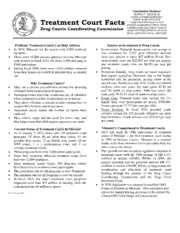
Treatment Court Facts January 2013 PDF
Preview Treatment Court Facts January 2013
Commission Members GEORGE W. DRAPER, III JUDGE LAWRENCE MOONEY Treatment Court Facts JUDGE MARCO ROLDAN COMMISSIONER PEGGY DAVIS GEORGE LOMBARDI-CORRECTIONS Drug Courts Coordinating Commission ANDREA SPILLARS-PUBLIC SAFETY MARK STRINGER-MENTAL HEALTH BRIAN KINKADE-SOCIAL SERVICES Problems Treatment Courts Can Help Address Return on Investment in Drug Courts In 2010, Missouri led the nation with 1,960 meth-lab Incarceration: Potential incarceration cost savings or incidents. cost avoidance for 2,707 adult offenders diverted There were 18,086 persons admitted into the Missouri from state prisons is about $27 million. Fiscal 2011 state prisons in fiscal 2011. Of these, 6,686 had drug or incarceration costs are $22,852 per year per person, DWI convictions. and treatment courts costs are $6,190 per year per During fiscal 2008, there were 1,916 children removed person. from their homes as a result of parental drug or alcohol Probation: Initially, drug courts are more expensive use. than regular probation. However, due to the higher recidivism rate for probation, savings result in the Why Treatment Courts? second year. Based on a city of St. Louis cost-benefit They are a proven cost-effective method for diverting analysis, after two years, the state gains $2.80 for offenders from incarceration in prisons. each $1 spent on drug courts. After four years, the Treatment courts lower the recidivism rate of offenders state gains $6.32 for each $1 spent on drug courts. when compared to either incarceration or probation. Foster Care: Potential foster care savings for 313 They allow offenders to remain in their communities, to family drug court participants are nearly $500,000. support their families and to pay taxes. Foster care costs $7,773 per year per child. Treatment courts reduce the number of babies born Youth Services: In fiscal 2010 potential youth addicted. services savings for 115 juvenile offenders are more than $6 million. Youth services cost $53,032 per year They reduce crime and the need for foster care, and per youth. they help ensure that child support payments are made. Missouri’s Commitment to Treatment Courts Current Status of Treatment Courts in Missouri 2013 will mark the 20th anniversary of treatment As of January 1, 2013, there were 135 treatment court courts in Missouri – the first treatment court started programs. Of these, 90 are adult drug courts, 11 are in 1993 in Jackson County. Missouri is a national juvenile drug courts, 12 are family drug courts, 18 are leader, with more treatment courts per capita than any DWI courts, 1 is a reintegration court, and 3 are other state in the nation. veterans treatment courts. This growth was due in part to legislative adoption of These programs have over 3,600 active participants. treatment courts with the 1998 passage of HB 1147, Since their inception, Missouri treatment courts have codified at section 478.001, RSMo. In 2001, the had over 12,000 graduates. general assembly and the governor enacted HB 471, Since treatment courts began, 583 drug-free babies codified at section 478.009, RSMo, to help ensure the have been born to treatment court participants. coordination and allocation of treatment court The graduation rate for all programs is over 50 percent funding through the creation of the Drug Courts The retention rate for all programs is over 60 percent. Coordinating Commission and the Drug Court In fiscal 2013, the state’s treatment court programs Resources Fund. requested more than $14 million in funding while the In 2010, legislation was adopted to establish DWI commission has $6 million to spend. Courts or Dockets in Missouri. This legislation also allows for limited driving privileges to be granted by Revised January 2013 a Drug/DWI Court Judge or Commissioner.
